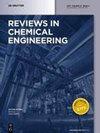Progress on the influence of non-enzymatic electrodes characteristics on the response to glucose detection: a review (2016–2022)
IF 6.6
3区 工程技术
Q1 ENGINEERING, CHEMICAL
引用次数: 1
Abstract
Abstract Glucose sensing devices have experienced significant progress in the last years in response to the demand for cost-effective monitoring. Thus, research efforts have been focused on achieving reliable, selective, and sensitive sensors able to monitor the glucose level in different biofluids. The development of enzyme-based devices is challenged by poor stability, time-consuming, and complex purification procedures, facts that have given rise to the synthesis of enzyme-free sensors. Recent advances focus on the use of different components: metal-organic frameworks (MOFs), carbon nanomaterials, or metal oxides. Motivated by this topic, several reviews have been published addressing the sensor materials and synthesis methods, gathering relevant information for the development of new nanostructures. However, the abundant information has not concluded yet in commercial devices and is not useful from an engineering point of view. The dependence of the electrode response on its physico-chemical nature, which would determine the selection and optimization of the materials and synthesis method, remains an open question. Thus, this review aims to critically analyze from an engineering vision the existing information on non-enzymatic glucose electrodes; the analysis is performed linking the response in terms of sensitivity when interferences are present, stability, and response under physiological conditions to the electrode characteristics.非酶电极特性对葡萄糖检测反应影响的研究进展:综述(2016-2022)
葡萄糖传感设备在过去几年中经历了重大进展,以响应成本效益监测的需求。因此,研究工作一直集中在实现可靠、选择性和敏感的传感器,能够监测不同生物体液中的葡萄糖水平。基于酶的设备的发展受到稳定性差,耗时和复杂的纯化程序的挑战,这些事实导致了无酶传感器的合成。最近的进展集中在不同成分的使用上:金属有机框架(mof)、碳纳米材料或金属氧化物。在这一主题的推动下,已经发表了一些关于传感器材料和合成方法的综述,为开发新的纳米结构收集了相关信息。然而,丰富的信息尚未在商业设备中得到总结,从工程的角度来看没有用处。电极的响应依赖于其物理化学性质,这将决定材料和合成方法的选择和优化,仍然是一个悬而未决的问题。因此,本综述旨在从工程的角度批判性地分析关于非酶葡萄糖电极的现有信息;在干扰存在时的灵敏度、稳定性和生理条件下对电极特性的响应方面进行分析。
本文章由计算机程序翻译,如有差异,请以英文原文为准。
求助全文
约1分钟内获得全文
求助全文
来源期刊

Reviews in Chemical Engineering
工程技术-工程:化工
CiteScore
12.30
自引率
0.00%
发文量
37
审稿时长
6 months
期刊介绍:
Reviews in Chemical Engineering publishes authoritative review articles on all aspects of the broad field of chemical engineering and applied chemistry. Its aim is to develop new insights and understanding and to promote interest and research activity in chemical engineering, as well as the application of new developments in these areas. The bimonthly journal publishes peer-reviewed articles by leading chemical engineers, applied scientists and mathematicians. The broad interest today in solutions through chemistry to some of the world’s most challenging problems ensures that Reviews in Chemical Engineering will play a significant role in the growth of the field as a whole.
 求助内容:
求助内容: 应助结果提醒方式:
应助结果提醒方式:


